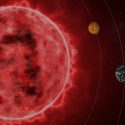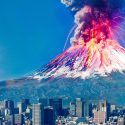Do you find the time it takes Earth to spin around each day a little slow? Well, how about we speed things up? A lot. What would happen to the length of our day?
What geographical and climate changes would occur? And at what point would life on Earth cease to exist?
The Earth makes one full rotation on its axis every 23 hours, 56 minutes and 4.1 seconds. And it’s not moving at the same speed everywhere. The rotational speed varies depending on your distance to the poles. If you’re at the equator, it moves the fastest at a rate of 460 m/s (1,000 mph). At the North and South Pole, it’s moving the slowest. Technically, it’s not moving at all.
This rotation makes Earth suitable for life. The diurnal cycle, or the shifting between day and night, helps keep the planet at a habitable temperature.
Earth’s rotation is the driving force of weather patterns. Even tides are affected by the Earth’s spin. So if we were to accelerate this rotation, would we completely destabilize the climate?
If you increased the rotational speed by 0.45 m/s (1 mph), our days would be shorter. But only by a minute and a half. You might not even notice the change. But even with this slight increase, sea levels would rise by several centimeters or a few inches. The water around the poles would migrate toward the equator.
If you increased this acceleration to 45 m/s (100 mph), a single day would be about 22 hours. You’d start to feel confused, almost like jetlag. We’d also need to add a few more days to the year.
But for sea levels, it would be a dramatic change. The world’s oceans at the equator would rise as much as 9 to 20 m (30 to 65 ft).
Places like New York City, Venice and Mumbai would be submerged. Millions of people would be displaced.
If we doubled the current rotation speed to 920 m/s (2000 mph), disaster would strike. Water would cover everything except for the highest mountains, such as Kilimanjaro or the highest summits of the Andes.
Satellites orbiting the planet would be out of sync as they orbit at a speed that matches the rotation. That would disrupt communications, television broadcasting and military operations.
You would notice some significant weather changes. The air would be heavy with moisture. Dense fog, clouds and constant rain would be the norm in regions near the equator.
If you keep speeding things up, at some point, you could fly off the planet. That’s because the centrifugal force of the rotation would be enough to overcome the gravity keeping you on the surface. This would happen at a speed of 7,886 m/s (17,641 mph).
You would experience reverse rain. Droplets of water would move upward in the atmosphere instead of falling. If you pushed the speed to 11,000 m/s (24,000 mph), the Earth’s crust would begin to flatten at the poles and bulge around the equator. Enormous earthquakes would rattle the planet.
There would be little chance anything on Earth could survive. But if you were to crank the velocity up more, like the speed of light, things would get wild.
If the Earth rotated at a speed of 299,792 km/s (186,282 mi/s), that would be 652,000 times faster than today. The dimensions of the planet would change. Once a sphere, Earth would contract into a thin disc-like shape. So would you, along with every other object. You could say it would become a flat Earth.
Rotating at this extreme speed would distort time on Earth. It would slow down so much that it would eventually stop. You would freeze in time. So hopefully, you would be caught in a good moment.
Earth could become a tiny black hole. That’s because an object moving at the speed of light has an infinite mass. Nothing would be making it out of this situation alive.



























